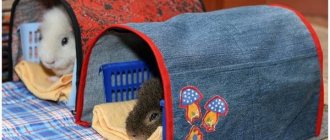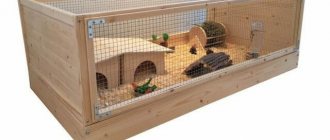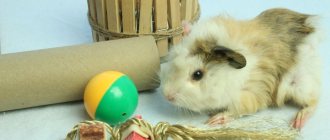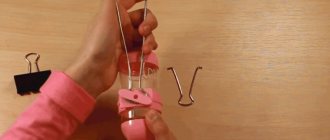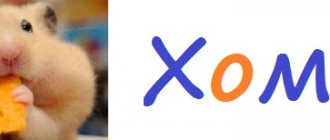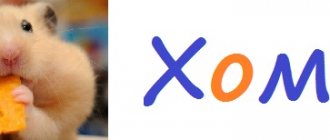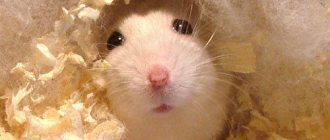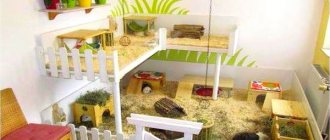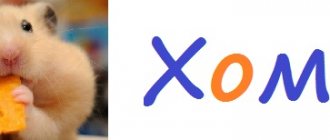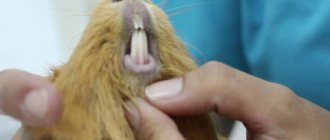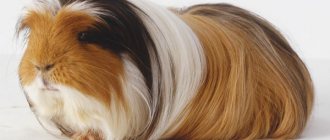When choosing a cage for a future pet, most breeders prefer to buy a ready-made version in a store. The abundance of colors, different materials and price allow you to choose the most suitable cage in a matter of minutes. However, all store-bought pig cages have the minimum required size, and large ones are very expensive. You can arrange excellent housing for one or an entire family of animals with your own hands - this will require very little time and materials, and the result will exceed all expectations.
The advantages of such housing for guinea pigs
Furry rodent shelving has many different benefits. The structure, like ordinary furniture, is easily matched to the interior. If you focus on the surrounding environment when creating a structure and developing its design, then the pig rack will become a real decoration of the room. Inside such a home there is a place to place everything that a pig needs to be happy:
- privacy shelters;
- feeders and drinkers;
- stairs;
- tunnels, etc.
There is no need to make playgrounds separate from the main housing - all attractions and sports equipment can be placed on the same or different levels of the rack. The pig will be able to have fun any time she wants. The presence of several floors allows you to create a multi-room house for the animal with areas for a specific purpose - a bedroom, a dining room, a playroom, etc. Transparent front sides provide a good overview, you can keep an eye on your pet and control where exactly it is and what it is doing.
The dimensions of the rack and, again, its multi-level nature make it possible to accommodate more than one pig in such a house. In this kind of “cottage”, rodents will not fight for territory - there is enough space for everyone. And, if something happens, the neighbors will be able to go to different rooms.
Compared to a regular cage, the shelving design makes much less noise when the pig is getting busy. In addition, through the walls and ceilings of such a structure, debris (particles of bedding, filler, etc.) practically does not get out, unlike the bars of the cage, through which all small elements fly out.
How to choose and where to place?
Before getting a guinea pig, you first need to purchase a cage to house it. Since there is a chic assortment of pet houses on the market, it will be difficult to make the right choice in favor of one model or another.
When purchasing cells, experts recommend paying attention to the following parameters:
- Design size. Guinea pigs need horizontal space and there should be plenty of it. The larger the area of the house, the more freely the animal will be able to move. In cramped cages, the rodent will begin to feel sad and sick. Since on average it is necessary to allocate at least 70 cm2 per pig, the best option would be to purchase a cage measuring 75x90 cm. For two individuals, therefore, a larger structure will be required.
- Free access to cleaning and ventilation. Since the furry house should be cleaned and washed regularly, its design should have removable elements.
- Quality. All locks, doors and bars must be secure. Metal cages are a good choice for keeping guinea pigs; they are the most durable. A combined structure made of plastic and metal rods is also suitable for comfortable housing.
- Form. Rectangular designs are best suited for pigs; it is not recommended to buy multi-level and tall models.
- Ability to fold and disassemble. Prefabricated models are universal because they are easy to store and transport.
- Distance between rods. They should be at such a distance from each other that the animal cannot stick its head through. The ideal option is 2.54x10.2 cm.
- Compliance with the design of the room. Today, manufacturers produce various cell models that differ in color and decor.
After the rodent cage has been purchased, the only question left is its arrangement and selection of a place for installation. It is worth immediately noting that the position of the cell is of great importance. For example, it is not recommended to place the house in or near the kitchen. This is due to hygiene standards
Therefore, in order to correctly locate the rodent’s habitat, it is important to take into account several factors.
- Microclimate of the room. Air temperature and humidity should always remain constant. The animal feels comfortable in a temperature range from 18 to +22 degrees, while the optimal humidity level is considered to be at least 40%. Since in winter there is often a temperature difference in the rooms, the cage cannot be placed on the floor; a bedside table or table is suitable for it. It is also not recommended to place houses with guinea pigs near doors and windows, since drafts are possible.
- Activity. This type of animal loves to be constantly close to people and requires special attention and care from its owners. Therefore, in order not to leave your pet alone, you can place it in the living room. But in this case, you will have to provide in advance the presence of a shelter in the cage where the rodent can hide when it gets tired.
- Noise. Guinea pigs have acute hearing, so their houses should not be placed near sources of loud sounds (TV, stereo system).
- Protecting your pet from other animals and children. It is advisable to place the cage in such a way that you can watch the kids play with the pet. If there are cats and dogs in the house, it is best to place the houses on a hill.
Some guinea pig owners arrange housing for their pets not in the house, but outside, under a special canopy. Such structures must be protected from the penetration of predators and bad weather. If the rodent lives in an apartment, then in the summer it is recommended to take it with you to the dacha. Fresh air and an assortment of green complementary foods will bring your fluffy a lot of pleasure and joy. In this case, the cage should be placed in a place where there is no extreme heat, dampness, cold, and there is protection from direct rays of the sun and rain.
There are also certain restrictions on the placement of cells, so they cannot be kept in the following places.
- On the windowsill on the sunny side and under the glass roof in the greenhouse. It will be very hot for the animals there.
- In the garage. Exhaust gases constantly accumulate in this room, which are poisonous and dangerous not only to the health of the animal, but also to humans.
- In unheated rooms. This type of pet should not be overheated or overcooled. It is also not allowed to warm the room where the pig is located with kerosene gas or a kerosene lamp. These heat sources emit many harmful gases.
Cage Making Guide
So, if a terrarium or a purchased enclosure with a pen does not suit you, then you can always make a house for a rodent on your own. Moreover, if you have good instructions, you can make a large enclosure with a pen, equipped with additional shelving.
Required tools and materials
- corrugated cardboard (quantity depends on the drawing); metal grill with small mesh size; plastic cable ties; adhesive tape; knife; scissors; meter or tape measure; pencil.
Drawing up a drawing
Drawing for manufacturing the structure
As you already understand, the size of an enclosure with a pen for an animal should be large, naturally, if space in the apartment allows. Taking this into account, it is necessary to make a corresponding drawing. In fact, there are many options for making an enclosure with a pen, we will consider one of them. A version of the drawing is shown above.
Assembly instructions
In accordance with the drawing, draw the base on the material, in this case corrugated cardboard. It is better to use corrugated cardboard for an enclosure with a pen because it is a multilayer material. Thus, if you cut through only one layer, this material will bend well. The red lines in the drawing mark those places of the first layer that need to be cut, and the black lines indicate what needs to be cut off completely; this can be done using a regular knife. When the cutting process is completed, you should begin assembling the structure; in this case, keep in mind that the protruding edges of the sides must be securely fixed with tape. This way you get a rectangular box, the height of the sides will be 15 cm if you make the designs in accordance with our drawing. Of course, the dimensions can be increased if necessary. You should install iron bars along the entire perimeter of the future home for the rodent; they should be cut into panels 0.3 m in size. The edges should be processed if necessary and bent in such a way that your pet does not get hurt during close contact. The metal panels themselves should be connected using ties prepared in advance, and they should also be fixed in the middle. All sides must be assembled separately, this is done so that the so-called walls can be adjusted to size. Then the lattice elements must be fastened together using ties, and they must be connected at right angles. You can also use plywood as a base, but this material will be less durable. As for the arrangement, in this regard, the cage must be equipped with everything necessary, in particular bedding, a drinking bowl, a feeding trough, a hay barn, etc. It all depends on the imagination.
One more point: if you have several rodents, and you do not want to keep them in one cage for certain reasons, then you can use racks. The rack can be small or large, like in pet stores. Racks are convenient because you can house several pigs in one place without taking up much space. But the rack is not so easy to find, and not everyone can make it with their own hands. You will also find photos of the racks below. Actually, the manufacturing procedure itself is not particularly complicated; anyone can handle it.
So, what you need to consider:
The cage must be equipped with everything necessary, otherwise the pet will not feel comfortable. For the bottom, use corrugated cardboard, plastic or other durable material that the pig cannot chew through. The iron for the grill must be as strong as possible, otherwise your pet will chew through it without any problems. Clean the cage regularly to prevent bacteria and disease. The cage must be made in such a way that it can be disassembled and washed without any problems; take this into account when assembling. The larger the space, the more comfortable the animal is. The air temperature in the room where the rodent is kept should be around 22 degrees. It shouldn't be too hot or cold here.
Pros of a cage made by yourself
A do-it-yourself guinea pig cage, made of thick cardboard and mesh, has many advantages over its store-bought counterpart. This is not only a significant saving of money. This is an opportunity to make a really large cage for a whole family of guinea pigs with several levels, shelters and ladders. A homemade cage can have a different shape and design and fit harmoniously into the interior of an apartment or even a balcony if it is insulated. A bedding made of soft and durable fleece will bring big savings. You don’t need to change it every time—just clean it of debris, rinse it under water if necessary, and put it back. A homemade cage will allow you to add new levels or houses or change the design after some time. You can create a cage in the shape of the letter L, multi-story, vertical - everything is limited only by the imagination of the breeder. From leftover building materials you can make a house for a guinea pig, a nursery for fresh grass or hay, a ladder or a labyrinth. The mesh makes a wonderful and comfortable crib.
Self-made cages are more durable and easier to use, and the animals feel free and happy in them.
You can find different versions of drawings - from the simplest to the most complex, and production will not take much time.
What should a home be like for a guinea pig?
A guinea pig is a fairly large animal compared to, for example, a hamster, so a more spacious home is required. The minimum dimensions of a shelter in which an animal can stay in relative comfort are 30*20*20 cm. A house for a rodent must have a set of certain characteristics:
- wide entrance;
- space;
- harmlessness;
- safety;
- good ventilation.
You should also take into account the peculiarities of the anatomical structure of these animals. Guinea pigs have a very fragile spine, so falling even from a small height can have fatal consequences. Two-story structures are extremely undesirable in a pet's cage.
Wide entrance
Considering the size of the animal, the entrance hole to the house should be at least 9-10 cm wide and the same size in height. If you plan to house several animals in one house, then there should be two entrances so that the animals do not crowd in the passage.
Space
As mentioned above, the minimum dimensions of the shelter for one animal are 30*20*20 cm. If several animals live in one cage, the length and width of the house should be increased. For adult pigs, you can provide separate houses - in addition to comfort, this will help avoid quarrels over territory, especially among males. For a female with cubs, a common house is suitable, which should be more spacious than for a solitary animal.
How many guinea pigs do you have?
Harmlessness
One of the most important criteria. Pigs taste absolutely everything that comes into their field of vision. The material from which the house is made must be non-toxic and suitable for grinding teeth. The exception is fabric houses - pigs do not try to gnaw them, except perhaps the frame on which the fabric is stretched.
Safety
No less important parameter than harmlessness. The pig house should not be too high so that the animal is not injured if it accidentally falls. This is especially true for structures with a flat roof, which animals love to climb. Multi-tiered structures are not suitable for guinea pigs, the same goes for ladders and transitions from one level to another.
Good ventilation
Not every animal can be trained to relieve itself in a certain place. Most likely, the pig will fulfill all its natural needs in the house. Therefore, it is advisable to provide the structure not only with an entrance, but also with a ventilation hole on the opposite or one of the side walls.
The house can be made from different materials
What types of enclosures are there?
Enclosures can have different “interiors”. You can make some tunnels and pipes so that the animal can run and hide through them. This is often made from cork oak. Guinea pigs love different decks. They can be made from bark. Ceramic toys and wicker baskets can be placed in the enclosure.
It is best to place an absorbent diaper on the floor of the enclosure. Old linoleum will do. You can throw in pieces of old natural carpet. Don’t forget to disinfect all this in a timely manner.
It is important to know that plastic items are prohibited. The rodent may begin to chew on such a toy and get injured.
Walking a guinea pig can be organized using a fence purchased at a pet store
Aviary dimensions and procedure
Before you start making, you should decide what size the pen will be.
Based on this, the minimum sizes are:
- for one animal - 1 meter by 80 cm;
- for two animals – one and a half meters by 80 cm;
- three pets will need about 1.7 m by 80 cm;
- if there are four or more pigs - 2 m by 80 cm.
When building, you need to take into account that the height must be at least 15 cm.
Once the dimensions have been determined, work can begin:
- Mark and draw the shape of the enclosure (its base).
- Measure 15 cm on each side. Connect the lines. These will be the sides of the pen.
- Cut carefully, following the line markings.
- Assemble the frame along the cuts.
- Fold the edges.
- Bend the parts that protrude. Cover them with tape.
As a result, there should be a box in front of you, only without a top. Now you need a metal mesh, the sides are assembled from it:
- The mesh is cut into pieces of the required size. The height of the walls should be twice the height of the pallet.
- Finish the edges to ensure there are no jagged edges or sharp corners.
- Connect the parts using a cable tie.
- Do not tie it very tightly, otherwise there will be a skew on the other side of the enclosure.
A corrugated cardboard pallet is placed inside a metal body, so the dimensions must correspond exactly.
This is what the finished version of the enclosure looks like
Also, the bottom should be additionally lined with rubberized mats - they can be washed frequently.
It is a good idea to purchase plastic pallets, as long as they are the right size.
If plastic is used in the construction of the enclosure, it must be covered with a PVC mat to prevent the pigs from gnawing
It is important for the owner to remember that it does not matter whether the enclosure is purchased or made independently. The main thing is that your pet feels happy and comfortable.
Country aviary
In summer, the animal is often taken out into nature. In order for the animal to feel comfortable there, it needs a built pen. The animal will be able to be outdoors and feel safe. The pegs are driven into the ground and the mesh is stretched. When a pig is in an enclosure, it needs to be monitored so that it is not disturbed by unwanted guests - dogs, cats. Birds can also be a source of danger, so the owner needs to be constantly on alert.
The enclosures are also made of wood. It looks like a box without a lid. It is usually spacious and insulated with special material (for example, polystyrene foam). The bottom slides out so it's easy to clean. The wooden surface of the box is impregnated with an anti-rotting agent and protects against various pests.
Country version of an enclosure for guinea pigs
Doing this indoors is prohibited, as guinea pigs love to try everything and can harm themselves by poisoning.
The handle must be installed in the shade. If it is windy or drizzling outside, your pet should be taken indoors.
How to make a hammock house
To make a house you will need:
- durable fabric 130 cm long and at least 30 cm wide;
- pieces of fabric 35 cm long and 25 cm wide;
- sling 200 cm;
- 4 carabiners for fastening;
- bias binding 150 cm long;
- a piece of rectangular plywood 30 cm long;
- thread, needle, centimeter and scissors.
For a piece of fabric 130 cm long, fold the edge with the outer side inward and hem it, leaving one side free. Plywood is inserted into the resulting pocket. You can use thick cardboard instead of plywood. Softer cardboard or padding polyester is wrapped into the other edge of the long sheet. It turns out two pockets. The free edges of the pockets are sewn together. The part of the product with plywood will be the floor of the house.
To strengthen the walls and roof, you need to cut the sling into two equal parts. The edges of the sling are burned to prevent unraveling. Each part is sewn along the walls and ceiling along the edges of the product.
Smaller pieces of fabric are sewn so that they form the walls and ceiling. The end result should be a square shape.
The frame of the house is ready. To make an entrance, you need to make a round hole in the rectangular shape of the fabric. This will be the entrance. It is better to process the edges of the hole or trim it with tape. The fabric itself is sewn from the end of the product. You can simply cover the back wall with fabric, or you can make another entrance there. It is better to make the entrance hole with a diameter of at least 15 centimeters. You can cut a circle by folding the fabric in half twice so that the center of the hole is in the resulting corner. Then cut off this corner at a distance of 7.5 cm from the edge. When you unfold the fabric, you will get a round hole.
Carabiners are sewn to the slings with strong ribbons or laces. The product is ready for use. All that remains is to hang the hammock in the cage at a height convenient for the pig.
There are different variations of hammock houses. They can be made cylindrical or in the form of tents.
Rodents prefer a house more than other types of hammocks because they can hide in it and relax from prying eyes.
Bath
If you are planning to get a chinchilla, then you already know that the animals bathe in volcanic sand. For bathing you need to purchase a special vessel.
This could be a special bath for chinchillas, made of plastic with a door. Or you can just buy a round vase.
My experience in choosing a bath for chinchillas!
I bought a swimsuit, it was uncomfortable for the chinchillas, they were somehow afraid of it, so I got a round crystal vase.
Does a guinea pig need a house in a cage?
There are several opinions on this matter. Of course, a guinea pig needs some kind of shelter where the animal can hide when scared, or rest if desired. But as to whether it should be a full-fledged house, a canopy or a sleeping bag, opinions differ.
The choice largely depends on the character of the pet. If the animal is tame, affectionate and willing to make contact with its owner, it is quite acceptable to equip the cage with a full-fledged house.
However, the behavior of the animal should be observed. On forums dedicated to caring for guinea pigs, some owners complain that after the animal was given a house, it became less sociable and began to avoid human society. At the same time, the animal spent almost all the time in the house and categorically did not want to be handled.
To avoid such a situation, breeders advise equipping the guinea pig’s home with a full-fledged shelter no earlier than 2-3 months after the animal appears in the house. During this period, the animal adapts and gets used to the company of people.
As an alternative, it is recommended to equip the cage with a hammock, which will also act as a canopy. Hang it at a low height (about 10-12 cm), and the animal will receive not only a comfortable bed, but also a roof under which it can hide if necessary. In this case, the animal is in the owner’s field of vision and can observe him.
You can make your own home
The advantage of a spacious cage
Some breeders believe that the advice to make a cage no longer has any scientific basis. However, the large area of the cage will allow the animal to move actively and not get bored even when the breeder does not have enough time to let the animal walk around the apartment. In the cage-aviary, the pig can play, run, explore the territory and even just go eat - it will take her time. Movement is a good prevention of diseases of the lungs, heart, kidneys, and stomach. A large cage will also allow each pig to have its own corner and its own zone of comfort and relaxation. This means fights between animals will stop. The area of the pig's house also plays an important role when the female is expecting offspring or already has offspring.
A larger cage is easier to keep clean. It is much more convenient to clean, change food and bedding. Watching animals frolicking in an enclosure is also much more convenient and interesting.
Purchased and DIY cage
Whether to buy a cage for your rodent or make one yourself depends on the financial situation and personal preferences of the owners. If you have the finances, you can choose nickel-plated metal products in the store, which will differ:
- long service life;
- spacious dimensions;
- attractive appearance.
Such a cell is almost impossible to damage. As for the materials for making terrariums, the following is used:
- organic glass;
- getinax;
- synthetic materials.
Ryzhik in a hammock
All these materials are durable, hygienic and safe. In addition, they are resistant to mechanical damage and chemical elements.
The bottom of the cage must be strong. It is best if it is made of high-quality and environmentally friendly plastic.
Attention! Cages made from combined materials are not particularly durable. Despite their low cost, it is better to opt for other products. As for the option of making your own cage, here you can build a structure of any size and from different materials
As for the option of making a cage yourself, here you can build a structure of any size and from different materials.
The advantages of making a rodent cage yourself include:
- saving your own savings. You can make a spacious and easy-to-use house for a whole family of guinea pigs;
- interesting shapes and designs. When manufactured independently, the product can be given any shape and different types of structures can be made. This can be a two-level housing with stairs and various shelters;
- aesthetic appearance. Properly designed housing for rodents will harmoniously fit into any room interior.
Another advantage of a homemade cage is that over time you can improve the design by adding new levels or a house.
As for the shape, the animal cage can be made in the shape of the letter L, vertical, horizontal and even multi-story. From the remaining materials after assembling the cage, it will be possible to make a house, a crib, or a feeding trough.
The main thing is to competently develop a drawing, select materials, and stock up on free time.
Cage equipment
After a new and spacious house for a guinea pig is ready, it must be equipped with everything necessary for a comfortable and happy life for the animal. The first thing you need is feeders. It is necessary to have a separate feeder for hay or grass, as well as for dry and succulent food. If there are several pets, then there should be several feeders so that the animals do not compete and fight for food. There should also be several drinking bowls.
You can also make your own drinking bowl and feeder. A bent and fastened metal mesh is a good substitute for a hay manger, and a drinking bowl can easily be made from an inverted plastic bottle. To do this, a hole is punched in the bottle cap into which a regular drinking straw is inserted. The liquid will not spill if the hole diameter is slightly smaller than the diameter of the tube. The bottle is filled with water and attached to the outside of the cage, and the tube is inserted inside. Pigs quickly learn to drink from it, and the water always remains clean and fresh. The main condition is that all feeders and drinkers must be located in the same feeding area. Next, you should place shelter houses in several places in which the animals can rest.
You can make a house with your own hands from plywood or durable cardboard, or you can buy a ready-made version in a store.
As houses, some breeders use clay flower pots, cardboard boxes, and even wooden bird cages from which the bars are removed. There are quite a lot of options. If the cage is multi-level, several ladders should be installed. They are made from lattice or wood. You can also set up a play area for pigs and place a small labyrinth, several toys, balls or a comfortable hammock there.
How to do it yourself
A self-made enclosure will last longer, and the guinea pig will move freely in it. It won't take much time to build it.
What you will need
- Thick cardboard;
- metal mesh;
- cable tie;
- knife;
- scotch;
- scissors;
- pencil;
- ruler.
To protect the surface of the cardboard from moisture, it needs to be covered with several layers of tape. The cells of the metal mesh should be no more than three centimeters.
Manufacturing
Before you start work, you need to decide on the size of the enclosure.
It is important to remember that the larger the area, the more comfortable the guinea pig will feel. Therefore, the minimum dimensions should be:
- for one animal - 100×70 cm;
- for two - 140x70 cm;
- for three - 170x70 cm;
- for four or more - 210x70 cm.
Once we have completely decided on all the measurements, we get to work:
- Draw the shape of the base of the enclosure on cardboard.
- We measure 15 cm on each side and connect the lines. These are future boards.
- Carefully make an incision along the lines of the top layer of cardboard.
- We assemble the frame of the enclosure using the cuts.
- Fold the edges.
- We bend the protruding parts and glue them with tape.
You should end up with a large box without a top. This is the pallet of the future enclosure. Now you need to assemble the sides from the metal mesh. For this:
- Cut the mesh into pieces of the desired size. The height of the walls should be at least twice as high as the pallet.
- The edges are reliably processed from sharp corners.
- The finished parts are connected to each other using cable ties.
- The mesh box is secured to the pallet with cable ties.
The metal case will be inserted inside the cardboard pallet. Therefore, it must fit exactly in size.
Necessary materials
- Multilayer and dense corrugated cardboard, Metal mesh or grid with a mesh no larger than three centimeters, Ordinary plastic cable ties, Knife, Scotch tape, Large and small scissors, Pencils or markers for marking, Ruler.
It is best to use cardboard from large household appliances. It's more durable.
To ensure that the cardboard does not allow moisture to pass through, it must be glued on the inside with tape in two or three layers. Some people prefer to cover the inside with acrylic or even fiberglass. Cardboard is an ideal material - it is light, easy to work with, odorless and harmless, and also easy to find. You should be careful when choosing a metal mesh. The recommended mesh is three centimeters, but if you are keeping a family of pigs and planning to produce offspring, you must choose a mesh with a mesh no larger than a centimeter. Otherwise, the kids will crawl all over the apartment.
Housing for guinea pigs based on a metal rack
To build a multi-story “cottage” for your pet, a metal rack is suitable. The removable elements of this design can be easily swapped, adjusted in height, etc. If you need a larger house, it is enough to create a single structure from several racks.
One end of the house is covered with plywood or other material. A metal mesh is attached to the other end and back side. It is better to make doors from plexiglass. When building a home for an animal from a metal rack, the shelves are installed upside down to create a kind of pallets.
You can easily give your pet a luxurious home by making it yourself or simply giving an old closet a second life. A properly created shelving structure is not just a comfortable house for your pet. With a creative approach to the construction of this home, it will become a real decoration of the interior.
Tunnel
Chinchillas simply love tunnels! You can buy a ready-made one, but finding them is not so easy, or you can make it yourself.
My experience in arranging a tunnel for chinchillas!
Our tunnel is made of two sewer pipes of the largest possible size and a stationary elbow of a suitable size. Of course, everything is new, bought in a store. We simply fastened them together and drilled several large viewing windows into the pipes.
The result is a large corner tunnel, which must be stable, so we have it screwed to the enclosure.
Chinchillas are very excited about such “furniture” in the enclosure, they spend a lot of time there, sometimes even sleep in it.
How to train a guinea pig to a hammock
Accustoming to innovation should be done gradually. You should not place a new device in the cage of a pig that has only recently appeared in the house. To do this, the animal must live in the new place for at least two months.
After installing the hammock, the pet may get used to the update for several days, and then begin to be interested in it. The behavior of the pet after the appearance of the innovation needs to be observed. The pet can immediately start jumping into the new bed. If the hammock is located too high, then you need to identify this in time and move it lower.
If the animal does not show interest in the innovation, then you can lure it with a treat. But you shouldn’t get carried away with the food, as the new place can turn into a dining room.
If your pet gets nervous when new objects appear in the cage, then it is better not to make him nervous. You can try a more modest hammock or skip using one altogether.
A hanging lounger should not be frequently moved from place to place. This can only be done after the pet has completely gotten used to it.
Toys from improvised means
Inventing and making toys for small rodents at home is not only useful, but also exciting. In addition, making accessories yourself significantly saves the family budget.
Most often guinea pigs are offered:
- improvised grinding stones that are hung just above the floor of the cage - the animals first play with them, and then happily gnaw on them and grind down their incisors;
- old wooden cubes;
- soft toys - as a rule, rodents first sniff them, then take them to their house; a disheveled toy must be promptly replaced with a new one;
- Tennis or ping-pong balls are one of the most favorite toys of guinea pigs - they push the balls with their paws, head, and roll them around the cage;
- tubes from large paper napkins;
- wire (or twine) with treats strung on it.
How to arrange it?
Objects inside the home should be well attached to the walls or located on the floor. Inside the cage it is necessary to place a drinking bowl, a feeder, a tray for hay, toys, and wooden sticks. It is also necessary to provide the animal with a place of privacy.
With the help of a drinking bowl, the individual will not splash water onto the litter and will not be able to wet itself. The volume of the drinking bowl may depend on the number of pets inside the cage. If there are a lot of animals, then you can use several small drinking bowls.
There must also be a food area inside the individual’s home. It is necessary to purchase several feeders to sprinkle different types of feed. Green, juicy and tough food should be placed in different feeders.
A rodent that lives at home needs conditions similar to natural ones. The pet needs rough materials so that it can grind down its teeth. You need to put twigs inside the cage, but you shouldn’t put coniferous branches. Branches that have large bones inside the fruits must be dried in advance. You can also put a mineral stone inside the cage.
You can place hanging accessories as they will not cause injury to your pet if they are installed and secured correctly. For example, it is worth taking a closer look at hammocks on which sea pets can relax.
The animal is shy and modest. Next to caring people, the individual will become more sociable and bolder. But your pet still needs an area so that he can have some privacy. Inside the cage you should arrange a secluded corner, for example, a house.
If there are many rodents inside the cage, they will fight for it. Instead of a simple house, you need to put up a canopy or fence the entire cage with good material. Another option is to use a pipe made from compressed hay.
If a guinea pig is constantly hiding inside the house, then it will be impossible to tame it, since inside it the animal may feel isolated and cannot see people. In order for the pet to get used to the person, the house needs to be temporarily replaced with a handful of hay.
You should buy toys for the animal so that your guinea pig can have some fun. With the help of toys, your pet will be able to quickly explore the entire territory of the cage. In order for the animal to move more, you need to constantly change toys.
If you put a ball of hay in a cage, many rodents will be able to pull the straws out of it. But this design will not be convenient for eating. You can put both a special tray and a ball.
These pets feel comfortable in an area that looks like a hole. For this reason, it is necessary to purchase toys that are shaped like a pipe. If several animals live inside the cage, then you need to purchase several pipes. Pipes can serve as a shelter if pets conflict with each other. Also, pipes and labyrinths can make your pet’s life more interesting.
The animal can become interested in various labyrinths for a long time. The main thing is that the rodent is active, as this has a good effect on the pet’s health - it will not become obese.
To learn how to make a cage with your own hands, see below.
Why an aviary?
Small cages will never allow your pet to satisfy his need for the desired activity. In addition, the bars in the cage can pose a danger to the animal's teeth and lips - guinea pigs often chew on metal rods. The owners are perplexed why this is happening, because everything they need is there. Unlimited water and food.
But they don't realize that the animal gets stressed from the confined space and goes into psychosis. Stiffness has a depressing effect on his psyche. Your guinea pig may become lethargic. Sometimes he begins to eat a lot or, on the contrary, loses his appetite. Therefore, experienced and caring breeders equip so-called pens for their pets in the apartment. To prevent the rodent from feeling imprisoned, buy or make a spacious enclosure with your own hands.
If you have free space in the house, you can arrange this type of enclosure
Instructions for creating a children's house with your own hands
So, the most common option, perhaps, is to make houses from wood. Let's look at the instructions that will help us recreate it with our own hands, creating a safe and interesting play space for the child.
We decided to make a house of a traditional type and small size, having the following parameters: 160 by 160 by 140 centimeters. The height of the ridge of this structure will be only 90 centimeters. So let's get started.
Drawing No. 1
Drawing No. 2
Drawing No. 3
Drawing No. 4
Step No. 1 – collect the necessary materials
A wooden house for a child is a small analogue of a serious structure, so its construction should be approached in the same way as you would approach the arrangement of a real-size house. To assemble such a real small house, you need to first stock up on some materials. Namely:
- foundation blocks, 4 pieces;
- timber for laying the floor, 11 pieces;
- floor boards, 4 pieces;
- timber for roofing, 5 pieces;
- edged boards.
- lining for finishing;
- figured platbands;
- furniture panel;
- ondulin for the roof;
- paint of the desired shade;
- mounting angles;
- beam holders, 6 pieces;
- screws;
- nails.
You also need to prepare a traditional set of construction tools, and you can get to work.
To create a house, stock up on lumber
Step No. 2 – install the foundation and assemble the floor
Before starting major work on the foundation, it is necessary to fold the frame, connecting the beams together. It will be the standard for the rest of the work associated with creating a house for a child.
First, we connect the boards, turning them into the frame of the future foundation of our house
The base must be aligned diagonally and reinforced with metal corners.
Next, we find a flat place on the site, place a frame on it, and mark points on the corners of this frame. At these points, recesses are dug, inside of which we will later place blocks for the foundation.
Blocks for the foundation will then be placed at the corners of the frame.
So, we place our blocks in the dug holes. Each of the recesses must first be filled with sand approximately the size of the bayonet of one shovel.
The laid blocks and the frame placed on them will need to be isolated from each other, covered with a layer of waterproofing.
Connecting the frame and foundation
The finished frame is sewn up with cut boards, which we previously prepared to create the flooring, and we get a fully assembled lower segment of this house.
Prices for popular models of jigsaws
Jigsaw
We have a stable floor for the future house
Such security, in turn, will maximize the service life of the structure being created.
Step No. 3 - create a frame
Now we need to build the frame of the future house. First, on the surface of the newly created floor, you need to create markings for attaching the timber.
Consistently attach beams to the floor surface of the house, creating a frame for children's housing
By analogy with the image presented in this step, you will need to sequentially fill the timber, measuring its individual parts. Do this carefully, as the rafters will then be placed on top of the frame.
Step No. 4 - install the rafters
We make markings, only this time for the rafters. We attach ready-made, pre-assembled rafters, in the amount of three pieces, onto a securely fastened frame.
We fix the rafters on the previously assembled frame
Step No. 5 - sheathing
Now we have to cover the house. Using lining, it is necessary to fill the empty space in the finished wall frame.
The frame is covered with clapboard, and the roof is covered with carved boards
The roof of the roof is sheathed with carved boards, and the outside is lined with ondulin, laid on both sides of the canopy. It is very convenient to cut ondulin with a grinder.
Ondulin is an ideal coating for the roof of a children's house
Step No. 6 – decor
As you remember, we stocked up on carved frames. Now is the time to decorate with them:
- doorway;
- window openings.
We decorate the corner parts of the outer side of the building with curly overlays.
Overlays and curly trim will help give the house an elegant look.
Step No. 7 – arranging the interior
So that the children have something to play in the house, install homemade tables and benches inside, having previously treated them against parasites and carefully sanded them so that they do not accidentally get a splinter. In principle, you can install a purchased set of children's furniture inside.
The house must be filled with some kind of furniture for the convenience of children
Gnawing
Chinchillas are rodents and their teeth grow throughout their lives, so they need to be ground down. To do this, the enclosure must always contain dry twigs or cut logs from approved tree varieties.
Chinchillas can be given branches of apple, pear, willow, rowan, birch, black currant, hawthorn, raspberry, linden, rose hip and alder.
My gnawing experience!
I always have twigs in my enclosure! They are necessary for the proper growth of teeth and proper bite of animals. The branches go away quickly.
Basic requirements when creating a cell
A guinea pig needs a spacious home in which it can move freely and have fun. In addition, the parameters of the cage must be such that the animal can be safely taken out or put in.
At the same time, the enclosure must be durable, since a domestic rodent can chew through not only cardboard, but also wood. The most advantageous option would be a housing with a plastic bottom and an easily removable upper part.
It is very important that the rodent cage meets the following requirements:
Smooth, smooth ceiling, floor and walls. They must also not contain cracks or burrs. Ease of care. Cleaning the home, removing dirt, disinfecting and feeding should take place in maximum accessibility and comfort. Access to light and air. There should be constant daylight and fresh air flow. To keep several animals you need to have several cages
This condition is important to prevent disease outbreaks. In this case, the blocks will be difficult to disinfect, unlike a separate cell.
Best solutions
The best decision would be to buy an enclosure made taking into account all the needs of guinea pigs. Such cages have a plastic bottom, which is equipped with a pull-out tray. This feature will make it easy to clean up your pet’s home, and the plastic sides will prevent sawdust from flying around the room.
The walls are made of metal, and special places are equipped with fasteners for feeders and drinkers.
Enclosures presented in pet stores can be equipped with a second tier . This adds more space for your guinea pig to move around. The two-story structure allows you to place many passages inside the enclosure and divide the space into zones.
Do guinea pigs have fleas?
Making a cardboard house
To make a structure from sheets of thick cardboard, you will first need to make drawings. The steps are similar to the process of making a house from wooden plywood. But in the case of cardboard, you will need a safe, non-toxic glue instead of nails. The advantage of cardboard is the ability to make carved decorations without much effort. A house decorated with beams and carved elements looks more attractive
It is important to remember that the glue must be allowed to dry completely before using the finished product for its intended purpose.
Corrugated cardboard can be used as a material.
Pros and cons of wooden houses
In the popularity rating, wooden structures take the lead. They can have several floors and are equipped with ladders, beams, and a running wheel. Wooden homes have pros and cons. You need to study them carefully before making your final choice.
Main advantages:
- a large assortment allowing you to make a good choice of model;
- reasonable price that does not require large expenses;
- Simple maintenance, consisting of weekly brushing and wiping with a damp cloth.
Main disadvantages:
- high risk of damage to the house by a rodent, reducing its service life;
- absorption of odors;
- low weight, instability;
- danger of poisoning with varnishes and glue.
When choosing a wooden accessory, you need to pay attention to the quality of surface polishing. If there are notches, the chinchilla will cling to them. It is necessary to take into account that if the house has a pronounced unpleasant odor, the animal will not enter it.
Manufacturing procedure
To prepare for work, a diagram is made taking into account all specific dimensions. You can take any drawing of a rack or shelf as a sample. Substitute your dimensions, making sure to check whether the rack will fit in the space allocated for it.
Rack drawing
Don't make the shelves too deep, as this will make cleaning difficult. The distance between floors should be sufficient so that the pigs can stand on their hind legs if necessary. Once the drawing is ready, start manufacturing:
The finished diagram is transferred to the material using a marker with a ruler. To cut parts from wood, use a jigsaw or hacksaw. If necessary, a frame is assembled from wooden blocks. The base and ceiling of the second floor are treated with silicone sealant or other waterproof impregnations. Another option is to purchase plastic trays for the filler, but it is not always possible to find the right size. The side walls are attached to the base using tie screws or self-tapping screws. Large ventilation windows should be installed at the first floor level. The side windows are covered with a mesh, which is secured with screws. The ceiling of the second floor is installed, a hatch hole for the ramp is made in advance. The top floor can be left open for better ventilation; the absence of a ceiling will also make cleaning easier
It is important that the walls are higher than 30 cm, then the pig will not be able to jump out and hurt itself. If you decide to close off the second floor, you can use drop-down plexiglass doors. It is recommended to attach all doors to furniture hinges. Inside the rack you must place several shelters for resting and sleeping, preferably one for each animal
The pig will also like shelves and elevations. Don't forget about toys - otherwise the rodent will take on the parts of its home. In order to make it convenient for the animals to climb to the second floor, it is better to install not a wire staircase, but a ramp - a flat, wide board with glued slats.
Shelf with additional lighting
The rack itself must be placed at a sufficient height, at least 15-30 cm, otherwise the animals will be exposed to drafts.
The solution may be to install the product on a bedside table, which can be conveniently used for storing litter, hay and other accessories for caring for pigs. If there is insufficient lighting at the location of the rack, it is recommended to provide additional lighting. Attach hanging fluorescent lamps on each floor.
Tray and filler
Since many chinchillas go about their little business in wood filler, it is necessary to purchase a suitable tray.
You can buy a standard cat one, or you can buy one specialized for rodents, depending on your wishes.
I always take filler from light types of wood, often special for guinea pigs/rabbits/chinchillas.
My experience in choosing litter trays!
My chinchillas go about their business in a regular small litter box for cats, but I also have a tray for rodents.
Minimum requirements for conditions of detention
Before getting a guinea pig, it is important to create the necessary conditions for it. It is worth taking care that the animal does not become exhausted from lack of space.
Do not forget about the need to regularly ventilate the room in which the cage with the rodent will be located. However, drafts are prohibited for the animal
It is important to take care of good lighting, given that direct sunlight can harm your pet.
When the location of the enclosure has been determined, it is time to figure out what apartments the animal needs. It is not easy to name specific parameters, because they are individual for each guinea pig.
But it is important to consider the minimum requirements for a comfortable stay for a pet:
- 40x80 cm - the smallest dimensions of the cage, with a height of 50 cm;
- presence of a pallet. This condition will make the cleaning process easier. But you should not choose a container that is too deep, as the animal will lose the opportunity to look out;
- It is forbidden to neglect safety. Any chips, defects and cracks can cause harm to the guinea pig;
- convenient feeder. Practice will help you choose the right kitchen equipment for your animal. Some people prefer floor-mounted bowls, while others prefer pull-out or outdoor designs. The main thing is that it is convenient for the pet to eat, and he cannot turn the feeder over, spilling its contents;
- presence of hay. Hay is an essential nutritional supplement in a guinea pig's diet as it is the main source of protein. If there is such a piece of furniture for the pet, we will not scatter food throughout the cage;
- drinking bowl A guinea pig can use either a special device or a simple bowl. However, it is better to give preference to an automatic drinking bowl. This way, debris and pollution will not get into the water, and the litter will remain dry;
- filler. For rodents, compressed wood pellets are best. This filler absorbs moisture, eliminates odor and is used sparingly;
- house. Not a single living creature would refuse to rest in peace and quiet. Having a house in a cage will help the animal hide from the surrounding noise and get some sleep.
What does this little animal need?
First of all, of course, a spacious cage, made of metal rods with a high plastic tray, which can be easily removed if necessary. It is better to buy a large cage in advance with the expectation that the animal will grow up. Pigs are active, they need to run, otherwise their legs will be weak, and the animal will begin to suffer from obesity from the fact that all the time it just lies in the cage and eats its food. From time to time, it is advisable to let them run around the room (it is better to limit it to one room), and then the animal itself will not move further than it until it has explored everything, and this can take more than one week.
In addition to the cage, you need a feeder for hay and fresh grass (it is usually attached to the wall of the cage), a cup for grain feed (preferably a heavy ceramic one so that the pig cannot accidentally knock it over) and a nipple drinker. And don’t forget to buy filler for the cage; it’s best to buy regular sawdust, not granular ones, since pigs love to bury their heads in sawdust. You can also buy a mineral salt stone, on which the pig can grind its teeth; it is better to choose a round stone with a hole in the middle; it can be hung in the cage.
You also need a piece of tree bark or driftwood on which your pet can grind its claws, or you can buy special scissors at a pet store and trim your pet’s nails yourself, but I’ll warn you right away: this is not an easy task.
You can purchase a special wooden house in which the pig will sleep or can hide in case of danger.
Why do rats use shelter?
Tame domestic rats may use the cage house quite rarely, but this does not mean that they do not need it. All pets need shelter at certain times.
Stress
Even very tame rats are frightened by unfamiliar people, changes in their usual routine, and loud noises. Without a place to hide, your pet will develop stress, which can lead to aggression.
Bad mood, malaise
If an animal feels unwell, it feels an instinctive need to hide, to make sure that it is reliably protected.
Basic criteria for choosing an aviary
The chinchilla is a very large animal and needs spacious housing, and preferably it is not a cage.
Enclosures or display cases are built for chinchillas and they must be high. The fact is that the body structure of the animal is designed for jumping upward, because in nature they live in mountainous areas.
The size of the enclosure must be at least 50x50x70 , and preferably the height is at least a meter.
My experience in choosing an enclosure!
My enclosure is corner, it has a pentagonal shape and a height of 120 cm and a bisector drawn to the front wall of the enclosure is 95 cm long. This is a decent size and it fits my two chinchillas perfectly. Inside we have 4 shelves, arranged in a checkerboard pattern.
Now let’s look at the “furniture” in the children’s home.
Two-story design
To keep several pets, you can build two-story or multi-tier structures. The good thing about the two-story design is that you can separate the seating area and the food area. Multi-tiered structures can be equipped to accommodate several pets. In this case, assign each ward a tier. At the same time, each guinea pig should have its own drinking bowl and feeding trough, and a sleeping house.
Two-story and multi-tier structures are built by analogy with one-story ones. First of all, we create a drawing. When creating a drawing, you can look at pictures of cells offered, for example, by such a well-known company as ferplast. But, they are all of the same type, and are a rectangular structure of small sizes, similar to those for keeping guinea pigs, divided into floors. You need to equip the structure yourself. After installing the sleeping house, feeding trough, hay barn and drinking bowl, there is very little free space left, which does not allow the pet to lead an active lifestyle. Therefore, it is advisable to use your imagination when creating a drawing.
When arranging a two-story structure, cover the second floor with bedding. In principle, you can use any soft fabric, but the best bedding is a PVC mat.
running wheel
Running wheels for chinchillas are a controversial topic, because often animals simply drive themselves into them, and there are many cases of attacks in chinchillas due to the wheels. But, nevertheless, many chinchillas love to run on wheels and their owners buy them for them.
Wheels for chinchillas should be made of the finest mesh, or even wood without gaps. Chinchillas have small and very mobile phalanges of fingers, which the animal can damage on the wheel.
The wheel must have a very large diameter.
My experience buying a running wheel for chinchillas!
I'll be honest. I didn't buy the wheel because initially I couldn't find the right one, and then I just changed my mind. My animals have enough space in the enclosure and their physical activity is normal.
As you understand, my chinchillas are very different, but they are beloved and happy pets, to whom I provide everything that suits them. Furnishing a home for furry babies is necessary and very interesting.
Source
What you need to make a home pen
It doesn't take much effort to make a pen for a guinea pig with your own hands. To do this you need to prepare:
- scissors with wide tape;
- ruler with pencil;
- sharp knife;
- metal mesh;
- a piece of thick corrugated cardboard;
- cable tie.
Related article: Frequently asked questions about pet rats
To prevent corrugated cardboard from being exposed to moisture, it should be completely covered with tape in several layers.
Recommendations
The description of the construction process does not contain recommendations regarding covering the structure. This is due to the fact that the animal is not able to jump high. Therefore, the roof, which is installed in houses for birds solely to prevent them from flying away, is not needed in buildings for guinea pigs.
Another important point concerns such an element of a pet house as a false bottom. Its presence greatly simplifies caring for your pet. It is made from a mesh, which is installed 5-7 cm above the main bottom. The space between the bottom and the false bottom is filled with filler. Accordingly, with this arrangement of a house for a guinea pig, it will not move through its own waste and filler. But the presence of a false bottom significantly increases the risk of injury to the structure. Even if you manage to avoid problems such as dislocations and fractures, your pet will certainly begin to form corns. Alternatively, you can place a PVC mat on top of the false bottom. But feces will not pass through it. Accordingly, this solution will not simplify cleaning.
Article on the topic: Is it possible to walk a guinea pig outside?
